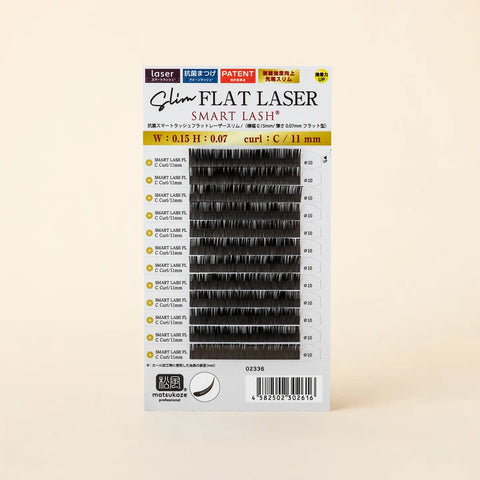Choosing Lashes: Thickness, Length, Curl Guide
To achieve your ideal look with eyelash extensions (or "matsu-eku" as commonly known in Japan), understanding the "characteristics" of each individual artificial lash is just as crucial as knowing the "types" we discussed previously. Thickness, length, curl, color, shape... these differences significantly impact the final look, retention, and even safety.
This time, let's delve deeper into the characteristics of artificial lashes, based on the provided PDF materials.
Choosing the Right "Thickness" to Define Your Look
The thickness of the artificial lash is a key factor in determining the volume and naturalness of the final look.
-
Common Thicknesses: 0.1mm, 0.12mm, 0.15mm, 0.18mm, and 0.2mm are typical.
-
For a Natural Look: 0.1mm to 0.12mm is recommended, as it's closer to natural lashes (approx. 0.05mm–0.08mm).
-
For More Volume: 0.15mm and above. However, thicker lashes are stiffer, can put more strain on natural lashes, and the adhesive bond might weaken, leading to poorer retention.
-
Most Popular: 0.15mm is widely used.
-
Note: Ultra-fine lashes (under 0.1mm) can have inconsistencies in thickness, length, and curl during manufacturing, and may lose their curl more easily.
Selecting the optimal thickness requires skill, considering the condition of the natural lashes, desired design, and retention goals.
"Length": The Key to Design - Basics and Precautions
Length offers design versatility but requires careful consideration.
-
Available Range: Typically 5mm to 15mm.
-
Main Sizes: 8mm to 12mm.
-
Upper Lashes: 9mm to 11mm (5mm–7mm might be used for eyeliner effects).
-
Lower Lashes: 6mm to 8mm.
-
-
Caution: Longer lashes experience more leverage and stress during wear, which tends to decrease retention. It's important to discuss longevity expectations with the client when choosing length.
-
Measurement methods can vary by manufacturer, leading to differences in labeled sizes.
-
Curl Types and Matching Tips
Curl dramatically changes the impression of the eyes. Matching the curl to the natural lash shape is crucial.
-
Main Types (Weakest to Strongest): AJ, J, AC, C, SC, SSC, etc. There's also a special L curl shape.
 The difference in curl shapes is for illustrative purposes. The names of the curls may vary depending on the manufacturer.
The difference in curl shapes is for illustrative purposes. The names of the curls may vary depending on the manufacturer.
What is "Tapering"? Defining the Finish
Tapering refers to the process of making the tip of the artificial lash gradually thinner, mimicking a natural lash.
-
Shallow Taper (Thicker Tip): Processed about 5mm from the tip. Creates a darker, more voluminous look.
-
Deep Taper (Finer Tip): Gradually thins from near the base towards the tip. Results in a more natural, softer impression.
-
Key Point: Even with the same thickness label, different tapers create different looks (density, softness). Understanding these characteristics is vital for proper use.

The differences are for illustrative purposes only.
Adding Personality! "Color" and "Functional Lashes"
Color:
-
-
Black is standard, but brown is gaining popularity.
-
A wide variety of colors like purple, blue, green, etc., are available, allowing for coordination with hair color or makeup to change the eye impression freely.
-
Mixing in a few colored lashes can create a lighter feel. Color sense and knowledge enhance their effective use.
-

Functional Lashes:
-
Lashes with special shapes (e.g., flat lashes), processing (laser etching), or added ingredients are developed to improve application efficiency, create a thicker appearance, or enhance adhesion strength.
-
Examples: NUMERO Matte Black, Flat Lash/Super Soft, Smart Lash Slim Flat Laser, NUMERO Pre-made Lash, NUMERO Color Flat Lash, NUMERO Volume Lash.
Stocking a variety of artificial lashes helps meet diverse client needs.
FLAT SUPER SOFT

It is the softest type available within the flat lash category.
Super Soft Flat Lash Product Page

The most precise artificial lash in terms of curl and length within the flat lash category.
NUMERO MATTE BLACK Product Page

NUMERO FLAT COLOR Product Page



【Important】Key Points for Safe Application
Pay close attention to the following for safe application:
-
Placement: Apply primarily on top or to the side of the natural lash. Ensure the base is visually confirmed and maintain a precise distance from pores, mucous membranes, and the eyeball.
-
Caution for Underneath Application: While sometimes used sparingly for very curly natural lashes, applying underneath increases the risk of the base getting too close to pores, mucous membranes, or the eyeball. Rubbing the eyes could cause the blunt base to scratch these sensitive areas. Apply with extreme caution if necessary.
-
Eyelid Sensitivity: The eyelid skin is thin and sensitive. Root lift or improper application can cause irritation, leading to swelling, itching, or redness.
Conclusion: Understand the Characteristics for Your Ideal Lashes
The characteristics of artificial lashes – thickness, length, curl, taper, color, and functionality – significantly influence the final look, longevity, and safety of your eyelash extensions. Beyond just the desired design, consider your own natural lash condition and consult with a trusted, skilled technician to choose the best options. This leads to a more satisfying and beautiful lash extension experience.
We hope this article serves as a helpful reference for your deeper dive into choosing lash extensions!

Explore our full range of professional lash products, designed for optimal performance and client satisfaction.




